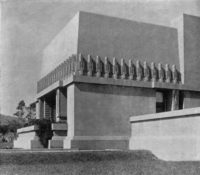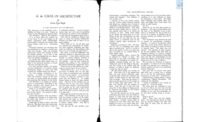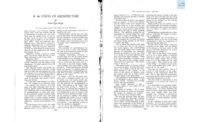Another conditions as far removed from creative work is the state of mind of those who, having in the course of their day’s labor put some stiches into the “clothes” of the work, assume, therefore, that style and pattern are rightfully theirs and wear them defiantly unregenerate. The gist of the whole matter artistically has entirely eluded them. This may be the so-called “democratic” point of view; at any rate it is the immemorial error of the rabble. No great artist nor work of art ever proceeded from that conception, nor ever will.
Then there is the soiled and soiling fringe of all creative effort, a type common to all work everywhere that meets with any degree of success, although it may be more virulent here because of low standards; those who benefit by the use of another’s work and to justify themselves depreciate both the work and the worker they took in from – the type that will declare. “In the first place, I never had your shovel; in the second place, I never broke your shovel; and in the third place, it was broken when I got it, anyway; - the type that with more crafty intelligence develops into the “coffin worm.” One of the Whistler’s “coffin worms” has just wriggled in and out.
But underneath all, I am constrained to believe, lies the feverish ambition to get fame or fortune “quick,” characteristic of the rush of commercial standards that rule in place of artist standards, and consequent unwillingness to wait to prepare thoroughly.
“Art to one is high as a heavenly goddess; to another only the thrifty cow that gives him his butter,” said Schiller; and who will deny that our profession is prostitute to the cow, meager in ideals, cheap in performance, commercial in spirit; demoralized by ignoble ambition?
A foolish optimism regarding this only serves to perpetuate it. Foolish optimism and the vanity of fear of ridicule or “failure” are both friends of ignorance.
In no country in the world do disciples, neophytes or brokers pass artist counterfeit so easily as in these United States. Art is commercialized here rather more than anything else, although the arts should be as free from this taint as religion. But has religion escaped?
So the standard of criticism is not only low – it is often dishonest or faked somewhere between the two, largely manufactured to order for profit or bias. Criticism is worked as an advertising game, trader’s instincts subject to the prevailing commercial taint. Therein lies the radically evil imposition that harms the public; that also further distorts, confuses and injures values and promotes bad work; that tends to render the integrity of artist and commerce alike a stand and unprofitable joke, and to make honest enemies even harder to find than honest friends. The spirit of fair play, the endeavor to preserve the integrity of values, intelligently, on a high plane in order to help in raising the level of the standard of achievement in the country, and to refrain from throwing the senseless weight of the mediocre and bad upon it – all this is unhappily too rare among editors. The average editor has a “constituency,” not a standard. This constituency is largely the average architect who has bought the “artistic” in his architecture as one of its dubious and minor aspects, or the sophisticated neophyte, the broker and the quack, to whom printers’ ink is ego-balm and fortune.
So until the standard is raised by plea or artist integrity is like a cry for water in the Painted Desert. As for competent criticism, the honest work of illuminating insight, where is it? Nothing is more precious or essential to progress. Where is the editor or critic not narrow or provincial? Or loos and ignorant? Or cleverly or superficially or cowardly commercial? Let him raise this standard! Friend or foe, there is still a demand for him even here; but if he did, he would fail – gloriously fail – of “success.”
Is architecture, then, no longer to be practiced as an art? Has its practice permanently descended to a form of mere “artistic activity?”
The art of architecture has fallen from a high estate – lower steadily since the Men of Florence patched together fragments of the art of Greece and Rome and in vain endeavor to re-establish it eminence manufactured the Renaissance. It has fallen – from the heavenly Goddess of Antiquity and the Middle Ages to the thrifty cow of the present day. To touch upon these matters in this country is double unkind, for it is to touch upon the question of “bread and butter” chiefly. Aside from the conscienceless ambition of the near artist – more sordid than any greed of gold – and beneath this thin pretense of the ideal that veneers the curious compound of broker and neophyte there lurks, I know, for any young architect an ever present dread of the kind of “failure” that is the obverse of the kind of “success” that commercialized standards demand of him if he is to survive. Whosoever would worship his heavenly goddess has small choice – he must keep his eye on the thrifty cow or give up his dream of “success”; and the power of discrimination possessed by the cow promises ill for the future integrity of an organic architecture. The net result of present standards is likely to be a poor wretch, a coward who aspires pretentiously or theoretically, advertises cleverly and milks surreptitiously. There is no real connection between aspiration and practice except a tissue of lies and deceit; there never can be. The young architect before he ventures to practice architecture with an ideal, today, should first be sure of his goddess and then, somehow, be connected with a base of supplies from which he cannot be cut off, or else fall in with the rank and file of the “good school” of the hour. Any one who has tried it know this; that is, if he is honest and is going to use his own material as soon as he is able. So the ever present economic question underlies this question of artistic integrity, at this stage of our development, like quicksand beneath the footing of a needed foundation, and the structure itself seems doomed to shreds and cracks and shores and patches, the deadening compromises and pitiful makeshifts of the struggle to “succeed!” Even the cry for this integrity will bind the legion together, as one man, against the crier and the cry.
This is Art, then, in a sentimental Democracy, which seems to be only another form of self-same hypocrisy? Show me a man who prates of such “Democracy” as a basis for artist endeavor, and I will show you an inordinately foolish egotist or a quack. The “Democracy” of the man in the American street is no more than the Gospel of Mediocrity. When it is understood that a great Democracy is the highest form of Aristocracy conceivable, not of birth or place of wealth, but of those qualities that give distinction to the man as a man, and that as a social state it must be characterized by the honesty and responsibility of the absolute individualist as the unit of its structure, then only cane we have an Art worthy the name. The rule of mankind by mankind is one thing; but false “Democracy” – the hypocritical sentimentality politically practiced and preached here, usually the sheep’s clothing of the proverbial wolf, or the egotistic dream of self- constituted patron saints – is quite another thing. “The letter killeth”; yes, but more deadly still is the undertow of false democracy that poses the man as a creative artist and starves him to death unless he fakes his goddess or persuades himself, with “Language,” that the cow is really she. Is the lack of an artist-conscience, then, simply the helpless surrender of the would-be artist to this wherewithal Democracy with which a nation soothes itself into subjection? Is the integrity for which I plead here no part of this time and place? And is no young aspirant or hardened sinner to blame for lacking it? It may be so. If it is, we can at least be honest about that, too. But what aspiring artist could knowingly face such a condition? He could choose to dig in the ditch and trace his dreams by lamplight, on scrap paper, for the good of his own should – a sweet and honorable, if commercially futile, occupation.








Post a comment to this article
Report Abusive Comment